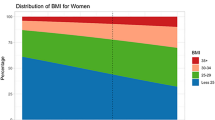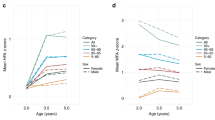Abstract
Background:
Obesity rates have increased markedly in recent years. This study investigated whether increases in adiposity over the past 10 years in England reflect across-the-board gains in adiposity or differential effects in subgroups.
Methods:
The data were from the Health Surveys for England, which include home-based measurements of height, weight and waist circumference in population-representative samples. Mean–difference (m–d) curves were calculated to examine increases in BMI and central adiposity at selected percentile points across the distribution between 1993/4 and 2002/3. The sample comprised 20 246 participants in 1993/1994 and 11 708 in 2002/2003. Patterning of population adiposity was examined in relation to gender, age and socioeconomic status (SES).
Results:
Both BMI and central adiposity increased markedly more in the upper part of the distribution, with intermediate increases in the middle and little change at the lower end of the distribution. The patterning and magnitude of increases in adiposity were similar for men and women, and for lower and higher SES groups. Increases at the top of the distribution were greater for younger adults, with the 90th percentile of waist circumference increasing by more than 8 cm in 10 years in young women.
Conclusions:
Gains in adiposity have not been equivalent across the BMI distribution. Thinner people in 2002/3 were almost as thin as they were 10 years earlier, but fatter people were considerably fatter. This could represent progressively greater responsiveness to the ‘obesogenic’ environment in individuals with higher complements of susceptibility genes. These population trends have important implications for future health and services to manage severe obesity.
This is a preview of subscription content, access via your institution
Access options
Subscribe to this journal
Receive 12 print issues and online access
$259.00 per year
only $21.58 per issue
Buy this article
- Purchase on Springer Link
- Instant access to full article PDF
Prices may be subject to local taxes which are calculated during checkout




Similar content being viewed by others
References
Rennie KL, Jebb SA . Prevalence of obesity in Great Britain. Obes Rev 2005; 6: 11–12.
Ogden CL, Carroll MD, Curtin LR, McDowell MA, Tabak CJ, Flegal KM . Prevalence of overweight and obesity in the United States, 1999–2004. JAMA 2006; 295: 1549–1555.
Flegal KM, Carroll MD, Kuczmarski RJ, Johnson CL . Overweight and obesity in the United States: prevalence and trends, 1960–1994. Int J Obes Relat Metab Disord 1998; 22: 39–47.
Daviglus ML, Liu K, Yan LL, Pirzada A, Manheim L, Manning W et al. Relation of body mass index in young adulthood and middle age to medicare expenditures in older age. JAMA 2004; 292: 2743–2749.
Flegal KM, Troiano RP . Changes in the distribution of body mass index of adults and children in the US population. Int J Obes Relat Metab Disord 2000; 24: 807–818.
Troiano RP, Flegal KM . Overweight children and adolescents: description, epidemiology, and demographics. Pediatrics 1998; 101: 497–504.
Jolliffe D . Continuous and robust measures of the overweight epidemic: 1971–2000. Demography 2004; 41: 303–314.
Visscher TLS, Kromhout D, Seidell JC . Long-term and recent time trends in the prevalence of obesity among dutch men and women. Int J Obes 2002; 26: 1218–1224.
Visscher TLS, Seidell JC . Time trends (1993–1997) and seasonal variation in body mass index and waist circumference in The Netherlands. Int J Obes 2004; 28: 1309–1316.
Kautiainen S, Rimpela A, Vikat A, Virtanen SM . Secular trends in overweight and obesity among Finnish adolescents in 1977–1999. Int J Obes Relat Metab Disord 2002; 26: 544–552.
Romon M, Duhamel A, Collinet N, Weill J . Influence of social class on time trends in BMI distribution in 5-year-old French children from 1989 to 1999. Int J Obes Relat Metab Disord 2005; 29: 54–59.
Sorensen HT, Sabroe S, Gillman M, Rothman KJ, Madsen KM, Fischer P et al. Continued increase in prevalence of obesity in Danish young men. Int J Obes Relat Metab Disord 1997; 21: 712–714.
Carpenter J, Bithell J . Bootstrap confidence intervals: when, which, what? A practical guide for statisticians. Stat Med 2000; 19: 1141–1164.
Hill JO, Wyatt HR, Reed GW, Peters JC . Obesity and the environment: where do we go from here? Science 2003; 299: 853–855.
Bell CG, Walley AJ, Froguel P . The genetics of human obesity. Nat Rev Genet 2005; 6: 221–234.
Wardle J, Carnell S, Haworth CMA, Plomin R . Evidence for strong genetic influence on childhood adiposity despite the force of the obesogenic environment. Am J Clin Nutr, in press.
Barsh GS, Farooqi IS, O'Rahilly S . Genetics of body-weight regulation. Nature 2000; 404: 644–651.
Friedman JM . Modern science versus the stigma of obesity. Nat Med 2004; 10: 563–569.
Flier JS . Obesity wars: molecular progress confronts an expanding epidemic. Cell 2004; 116: 337–350.
Giusti V, Suter M, Heraief E, Gaillard RC, Burckhardt P . Rising role of obesity surgery caused by increase of morbid obesity, failure of conventional treatments and unrealistic expectations: trends from 1997 to 2001. Obes Surg 2003; 13: 693–698.
Acknowledgements
This research was supported by Cancer Research UK.
Author information
Authors and Affiliations
Corresponding author
Rights and permissions
About this article
Cite this article
Wardle, J., Boniface, D. Changes in the distributions of body mass index and waist circumference in English adults, 1993/1994 to 2002/2003. Int J Obes 32, 527–532 (2008). https://doi.org/10.1038/sj.ijo.0803740
Received:
Revised:
Accepted:
Published:
Issue Date:
DOI: https://doi.org/10.1038/sj.ijo.0803740
Keywords
This article is cited by
-
Genome-wide association study of morbid obesity in Han Chinese
BMC Genetics (2019)
-
Progress and challenges in analyzing rodent energy expenditure
Nature Methods (2019)
-
Development and validation of the Self-Regulation of Eating Behaviour Questionnaire for adults
International Journal of Behavioral Nutrition and Physical Activity (2016)
-
Psychometric Properties of the Power of Food Scale in a Community Sample of Preadolescents and Adolescents
Journal of Child and Family Studies (2016)
-
Predictors of change in weight and waist circumference: 15-year longitudinal study in Australian adults
European Journal of Clinical Nutrition (2014)



